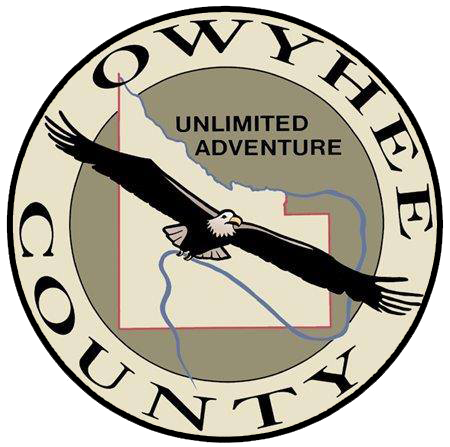Located in Idaho’s southwestern corner, Owyhee County is bordered by Nevada on the south, Oregon on the west, Canyon, Ada and Elmore counties on the north and Twin Falls County on the east.
2020 Census Population: 11,913
Elevation: 2,200 to 8,438 feet
AREA: 7,697 square miles
A Bit of History
On December 31, 1863, Owyhee became the first county created by the newly-formed Idaho territorial legislature. Owyhee is the second largest county in Idaho. The name, Owyhee, comes from early fur trappers. In 1819, three natives from Hawaii, part of Donald McKenzie’s fur-trapping expedition, were sent to trap a large stream that emptied into the Snake River. When they did not return, McKenzie investigated and found one man murdered in camp and no sign of the others. The stream was named in their honor. “Owyhee” is an early spelling for the word Hawaii. The Oregon Trail, the earliest road in the area, was used by emigrants for over 30 years on their long trip to the Oregon country. The part of the Trail in Owyhee County was known as the South Alternate Route or “dry route”. The Owyhee road was shorter but much harder than the main trail. Gold was discovered in rich placer deposits in the Owyhee Mountains in May, 1863. A search for the source of the gold led to quartz ledges on War Eagle Mountain. Before the fall of 1863 several hardrock mines were being developed. Three towns grew to supply the miner’s needs.
Booneville, Ruby City and Silver City were the first three settlements in the county. Only Silver City still stands, its well-preserved buildings a silent testimonial to the lively mining days. The beautiful ruby silver ore and the wealth of gold taken from the mountains made the mining district world famous. While Ruby City was named the first county seat, its population and businesses soon moved to a better location two miles upstream on February 1, 1867. Silver City was closer to most of the mining operations and had a better winter location. In 1934, after the decline of mining, the county government was moved to Murphy, more central to the livestock and agricultural sections of the country.
The first large cattle drive into Idaho came into the Bruneau Valley in Owyhee County in the fall of 1869. It took almost a year for several Owyhee County men to bring 1,400 head of Texas cattle up from the Brazos. These Durham cattle along with a few Texas Longhorns formed the nucleus of the County’s beef industry. At one time 100,000 head roamed the Owyhee hills. Owyhee County has a semi-arid, mild climate; rainfall varies from four to eighteen inches a year. Farming is almost exclusively through irrigation. Approximately 80,000 acres receive one or more irrigations per year. The climate and soil conditions are suitable for the production of a variety of crops, including alfalfa seed, sugar beets, potatoes, onions, corn and mixed grain.
Gold Discovered
About the first day of May, 1863, a party of 29 men led by Michael Jordan left Placerville on a prospecting tour of the tributaries of the Owyhee and Snake Rivers. They crossed the Snake River at the mouth of the Boise River. A stream near their first camp was named Reynolds Creek. While camped at Reynolds Creek, two of the men climbed the divide west of camp on a tour of observation. On the other side they discovered a large stream surrounded by timber-covered hills. The next morning the entire group headed in the direction of the reported stream. They reached it late in the afternoon of May 18th, at a point they named Discovery Bar about ten miles below the later site of Dewey. Dr. Rudd, not waiting to unpack his mule, took his shovel and scooped some loose gravel from the creek bank. He “panned it out,” recovering about a hundred “colors.” Each man followed suit, finding prospects of 25¢ to 50¢ to a pan. The excitement that followed can be better imagined than described.
GET IN TOUCH
Mailing Address:
P.O. Box 128
Murphy, ID 83650
Location:
20381 State Highway 78
Murphy, ID 83650
Phone: 208-495-2421
Fax: 208-495-1173
![]()
